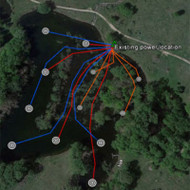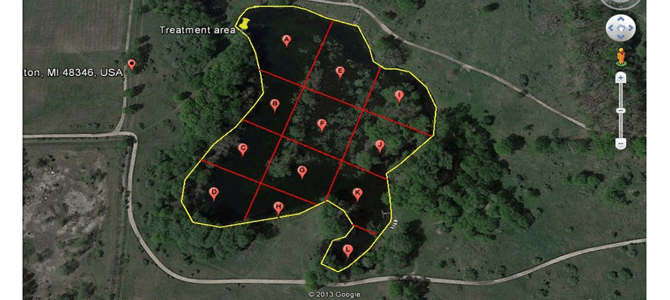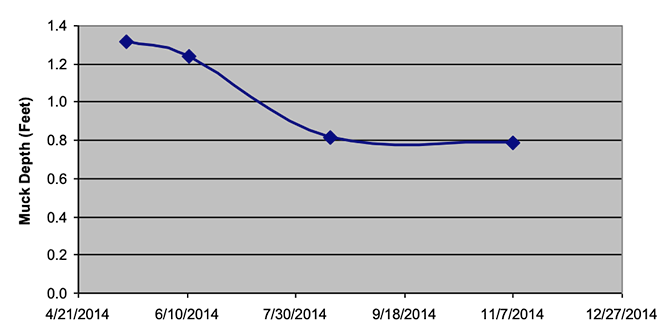
Muck Reduction Study - Using Aeration & MuckAway Pellets

Application: Fox lake, Oakland County, Michigan
Airmax Aeration (PS40 & SW40)
Abstract:
Justin McLeod, Airmax Fisheries Biologist
Fox Lake (Oakland County) is a shallow, 9 acre, low land lake characterized by heavy muck, prolific plant growth, and stagnant, eutrophic water. The property owners of Fox Lake desired to reduce plant growth and muck levels to facilitate better aesthetics and an improved fishery. Airmax developed a best management plan (BMP) for the lake, which included chemical treatments, bacteria augmentation, and aeration system installation. Installation of two Airmax
PS40's and one Airmax SW40 occurred in April of 2014 to circulate the water and deliver oxygen to the supplemental bacteria (Airmax MuckAway Pellets) that was applied throughout the summer. Muck levels were measured four times throughout the summer using a Sludge Judge and a grid sampling system. Muck levels decreased, resulting in a final average muck reduction of 6.35 inches.
Introduction:
In 2013, the owners of Fox Lake contacted Airmax, Inc. to begin reclaiming the waterbody from the excessive weed growth and muck that had consumed it. To regain control and return the lake to an aesthetically pleasing and fishable lake, Airmax, Inc. created the best management plan (BMP) for implementation. Following chemical treatments during the summer of 2013, an Airmax Aeration System was installed in the spring of 2014 (Figure 1.1).
Figure 1.1 – Aeration Layout (see image on left)
The aeration system was designed to turn over Fox Lake once per day to create an optimal oxygenated environment the aerobic bacteria to begin reducing muck on the bottom of the lake. MuckAway bacteria pellets, a blend of aerobic bacteria, were added to the pond during the 2014 summer to accelerate muck reductions and remove available nutrients from the system. Pond dye and a chemical treatment program rounded out the program to address aesthetics and nuisance weed blooms (milfoil/curly-leaf pondweed). Because muck reduction was one of the primary goals of the landowner, a sampling method was established to quantify changes in the lake bed.
Methods:
To measure muck reduction, a Sludge Judge was used to estimate the depth of muck in each of the 12 quadrants within Fox Lake. Within each quadrant, two sample locations were chosen by random chance to quantify the depth of muck. At each sample location within the quadrant, the Sludge Judge was deployed three times and the average of the three deployments was recorded as a single data point. To deploy the Sludge Judge, the user allowed the instrument to free-fall through the water column and sink into the muck. At its farthest depth, the surface of the water is recorded on the instrument. After an abrupt pull upwards (to close the foot valve), the Sludge Judge is pulled out of the water, and the depth of the muck within the column is recorded.

Results:
The study included four sample dates that yielded the following results:


Overall, 72 individual samples were collected onsite per sampling event (Each muck depth in Figure 1.1 is the average of three separate readings). Figure 1.3 below shows the average of these 72 samples per event fitted to a trend line to show the overall direction of the summer study.
By subtracting the final average from 11/7/14 from the beginning average on 5/13/14, we see that the total average muck reduction was 0.53 feet (6.35 inches).

The science of muck reduction is a largely un-investigated area. Following good theory and quality product development, pond product companies such as Airmax, Inc. have produced a set of products that have many good qualitative reviews. Quantifying these reviews has been a challenge, which is why there was a need to analyze Fox Lake scientifically. In summary, the management practices (particularly the aeration and bacterial augmentation) of Airmax, Inc. probably contributed to the over 6" muck reduction during the summer of 2014. The most dramatic decline in muck seems to coincide with the beginning of the MuckAway pellet applications (the application started in late May 2014). Further sampling would be required to eliminate variation by seasonal factors. Also, future studies could include the composition of the muck to determine what portions are being removed.
It should be noted that during the summer of 2014, some large and uncharacteristic algae blooms occurred. It is hypothesized that due to the new circulation (aeration installed) and the interruption of nutrient cycles (bacterial augmentation), there arose opportunities for fast-growing green algae to capitalize on large amounts of nutrients being cycled out of the system. It is also hypothesized that as the substrate is cleaned of detrital nutrients and the Fox Lake system finds a new balance, there will be fewer nuisance algae blooms throughout the summers.
From spring 2013 to fall 2014, Fox Lake has seen large improvements in aesthetics and fishing access. Future seasons should see similar reductions in nutrients and improvements in muck depths.
| PS40 | SW40 | |
|---|---|---|
| PondSeries System | PS40 | SW40 |
| Number of Diffuser Plates | 4 | 4 |
| Max Pond Size | 4 Acres | Up to 1/2 Acre |
| Max Diffuser Depth | 50' | 6' |
| Running Amps | 4.3 | 0.87 |
| Voltage | 115V | 115V |
| Max CFM | 5.6 | 4.9 |
| Monthly Operating Cost (24/7)* | $35.40 | $7.20 |
| Weighted Airline | 5/8" | 3/8" |
| Cabinet Dimensions | 23"L x 17"W x 15"H | 23"L x 17"W x 15"H |
| ProAir Diffuser Warranty | 5-Year | 5-Year |
| Compressor & Electrical Component Warranty | 3-Years | 3-Years |
| Composite Cabinet Warranty | 10-Year | 10-Year |
| EasySet Airline Warranty | 5-Year | 5-Year |
Application: Pellet
Active Temp: Above 50°F
Treatment: 0.5 - 1 Pound per 1,000 sq ft or 10-12 Pounds per Surface Acre
Shelf Life: 5-Years
Dosage Rates: Once the treatment area is established, calculate the treatment amount. For total lake treatments, treat every 4 weeks. For spot treatment areas (1,000 sq ft), treatments will be required every 2 weeks for best results.
How to Apply Pellets: Apply 10-12 Pounds per Surface Acre. Broadcast pellets evenly over the water or treatment area using a spreader.
When to Apply Pellets: Apply MuckAway every 2-4 weeks when water temperatures are above 50°F. Treatment should continue until desired results are achieved.
Restrictions: Pellets may be applied to lakes and ponds used for irrigation and aquaculture. Water treated with MuckAway may be used for recreation, fishing, and other activities immediately after treatment. Safe for recreational ponds, horses, livestock, birds, pets, fish, wildlife, and the environment. Not tested on water that will be used for human consumption.
